Community Life Survey 2021/22: Neighbourhood and community
Updated 3 May 2023
Applies to England
The Community Life Survey is a household self-completion survey (online survey, with paper survey for adults not digitally engaged) of adults aged 16+ in England. This chapter summarises results related to the respondent’s neighbourhood and community from the 2021/22 survey, which ran from October 2021 to September 2022.
Differences between groups are only reported on in this publication where they are statistically significant i.e. where we can be confident that the differences seen in our sampled respondents reflect the population.[footnote 1]
1. Neighbourhood
In 2021/22 the proportion of respondents who either said they ‘definitely agree’ or ‘tend to agree’ that they borrow things and exchange favours with their neighbours was similar to in 2020/21, following a gradual decline since 2013/2014. In 2021/22, 36% agreed compared with 37% in 2020/21, and 42% in 2013/14 (approximately 17 million adults in 2021/22 and 2020/21 compared to approximately 19 million adults in England in 2013/14).
In 2021/22, 72% of respondents (approximately 33 million people in England) said they chat to their neighbours at least once a month (more than just to say hello), in line with levels in 2020/21 (74%).
Figure 3.1: Percentage of adults (16+) who chat to their neighbours at least once a month (more than just to say hello), and the percentage who agree they borrow things and exchange favours with their neighbours, 2020/21 - 2021/22
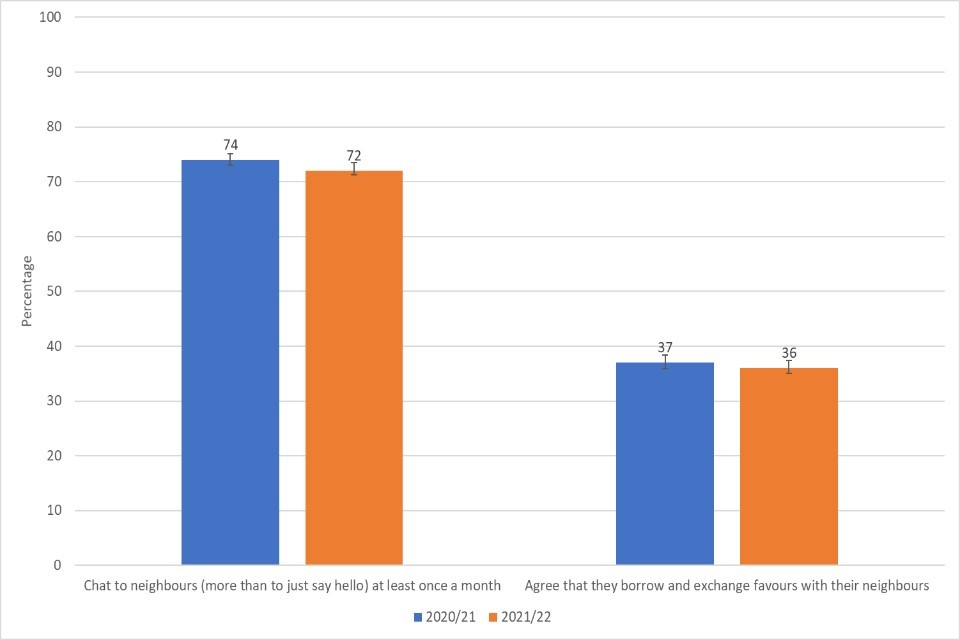
Overall there were some differences by demographic groups:
Respondents aged 16-24 were less likely to chat to their neighbours once a month or more than respondents from all other age groups (48% compared with 61% to 85%).
Respondents identifying as being from a white ethnic group (75%) were more likely to chat to their neighbours than respondents identifying as from any other ethnic group (ranging from 54% to 67%).
Respondents in London (65%) were less likely to report chatting to neighbours more than once a month than were those in other regions (72-76%), with the exception of the North East where levels were similar (72%).
Those living in rural areas were more likely to chat to neighbours than those in urban areas (81% compared with 70% respectively).
Respondents in the least deprived areas were more likely to chat with neighbours than those in the most deprived areas (76% compared with 67% respectively).
No variability was seen between respondents of different genders or between those with a disability or not.
Figure 3.2: Percentage of respondents who chat to neighbours at least once a month by age group, 2021/22
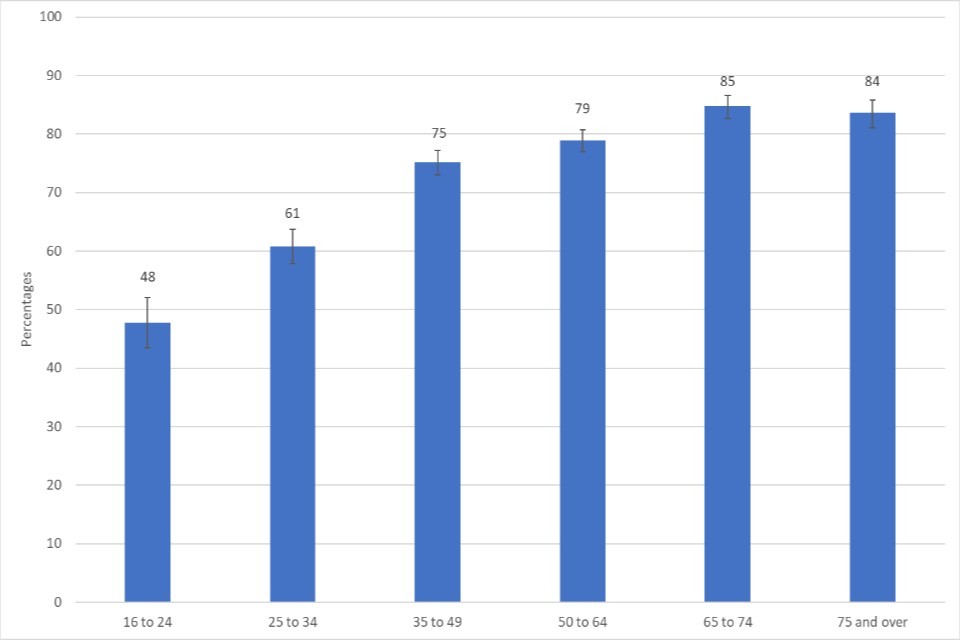
2. Community Cohesion
The percentage of respondents agreeing that their area is a place where people from different backgrounds get along well together has remained fairly consistent over the last eight years, with 84% agreeing in 2021/22.
In addition, in 2021/22, 58% agreed that people in their neighbourhood pull together to improve the neighbourhood. This is lower than in 2020/21 (65%), when levels were the highest the CLS had recorded since it began in 2013/14, but in line with levels in 2019/20 (59%).
Figure 3.3: Percentage of adults (16+) who agree their neighbourhood is a place where people from different backgrounds get on well together, and the percentage who agree people in the neighbourhood pull together to improve the local area, 2020/21-2021/22
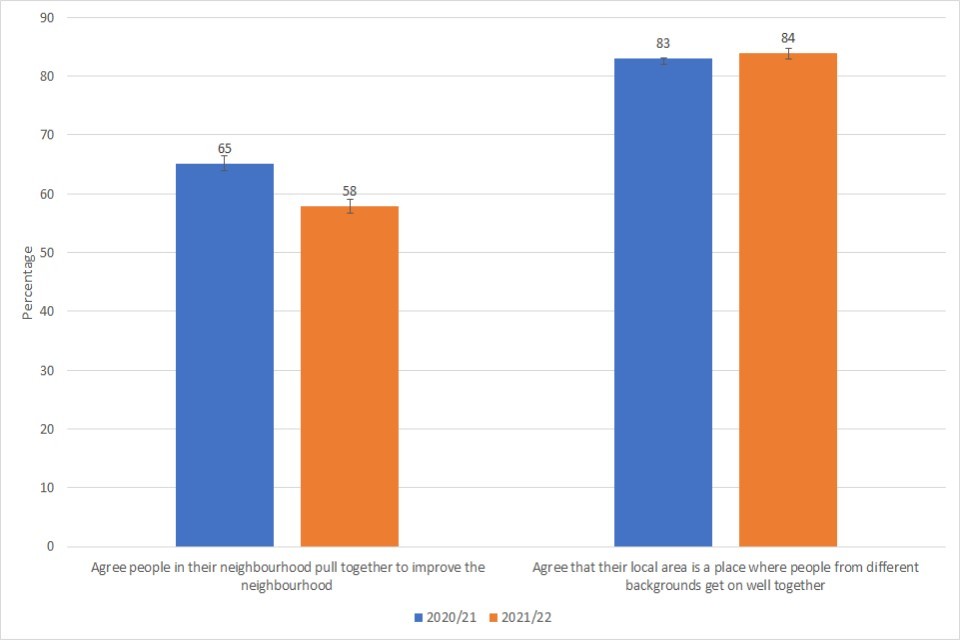
There was some variability amongst different demographic groups on the degree to which respondents agreed that their local area is a place where people from different backgrounds get on well together.
Those aged 65-74 (86%) were more likely to agree that their local area is a place where people from different backgrounds get on well with each other than those aged 35-49 (82%).
Respondents without a limiting long-term disability or illness were more likely to agree than those with (86% compared with 81%).
Those living in rural areas were more likely to agree (88%) than those living in urban areas (83%).
Respondents living in the least deprived areas were more likely to agree than those living in the most deprived areas (89% compared with 77%).
No variability was seen between respondents of different gender, ethnic groups or by region.
Figure 3.4: Percentage agreeing that their neighbourhood is a place where people from different backgrounds get on well together by Index of Multiple Deprivation quintile, 2021/22 [footnote 2]
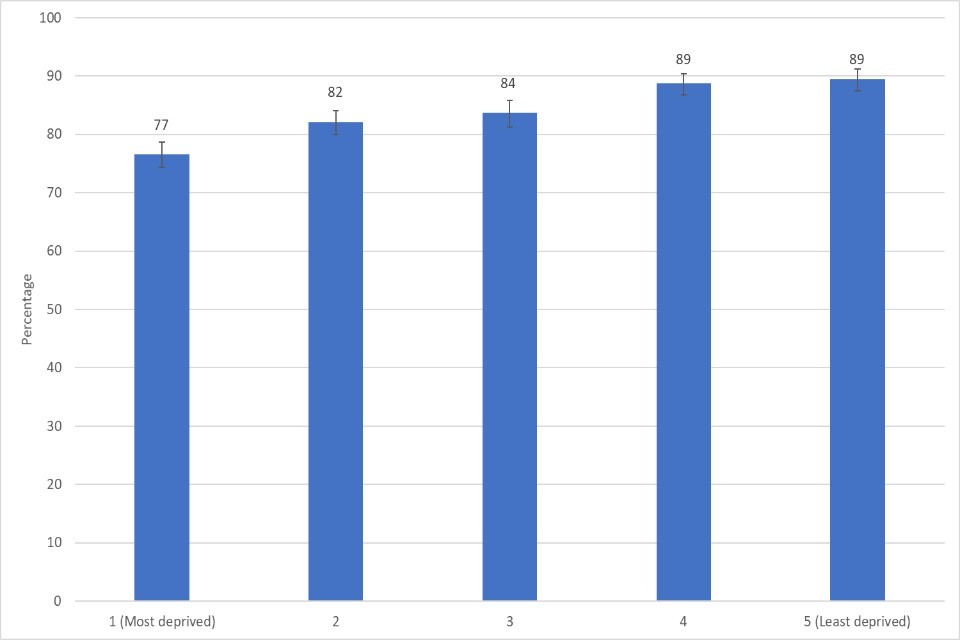
The percentage of respondents who agree that many of the people can be trusted in their local neighbourhood remained consistent in 2021/22 (41%) compared with 2020/21 and 2019/20 (41% and 40%). The percentage of respondents who said ‘none of the people can be trusted’ in their neighbourhood was 3% in 2021/22, similar to 2020/21 and 2019/20 (3% and 4%).
Figure 3.5: Responses to ‘thinking about the people who live in this neighbourhood, to what extent do you believe they can be trusted’, 2020/21 - 2021/22 [footnote 3]

3. Neighbourhood satisfaction
Overall, 76% were either very or fairly satisfied with their local area as a place to live, a decrease from 79% in 2020/21, but in line with levels in 2019/20 (76%). This is made up of 30% of respondents who said they were ‘very satisfied’ with their local area as a place to live, and 47% who were ‘fairly satisfied’.
Figure 3.6: Responses to ‘Overall, how satisfied or dissatisfied are you with your local area as a place to live?’, 2020/21 - 2021/22
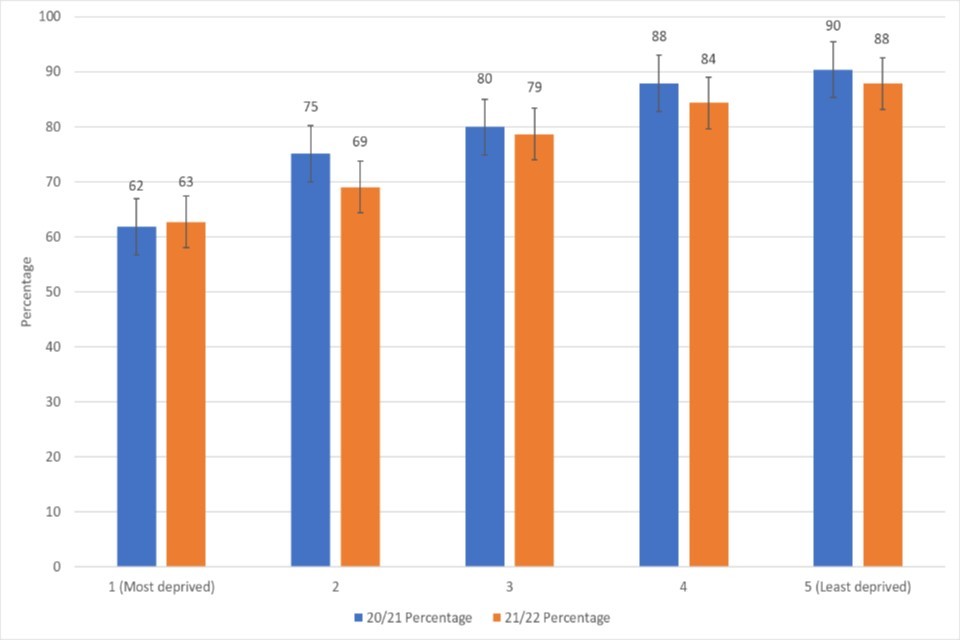
Overall there were some differences between demographics groups:
Those who identified as female were more likely (78%) than those who identified as male (75%) to report that they were satisfied with their local area.[footnote 4]
Those aged 75+ showed higher satisfaction in their local area (85%) than all other age groups (70-78%), aside from those aged 65-74 (81%).
In 2021/22, respondents identifying as being from white ethnic groups were more likely to be satisfied with their local area (78%) than those identifying from black ethnic groups (71%) or other ethnic groups (64%). Respondents identifying as being from a white ethnic group in 2021/22 were less likely to be satisfied with their local area than in 2020/21 (78% compared to 80%). No other differences between those identifying with being from different ethnic groups were observed.
Respondents with a long term limiting illness or disability (74%) were less satisfied in their local area than those without (79%).
Some regional variability was seen, with those from the South West (82%) more likely to agree that they were satisfied with their local area than those in the West Midlands (73%), London (74%), Yorkshire and Humberside (74%) and North West (74%).
More respondents living in rural areas (85%) agreed that they were satisfied with their local area than those in urban areas (74%). Respondents in urban areas saw a decrease in satisfaction with their local area compared to 2020/21 (77%).
A higher proportion of those from the least deprived areas (88%) reported satisfaction with their local area than those from the most deprived areas (63%).
Figure 3.7: Percentage satisfied with local area by age group, 2020/21-2021/22
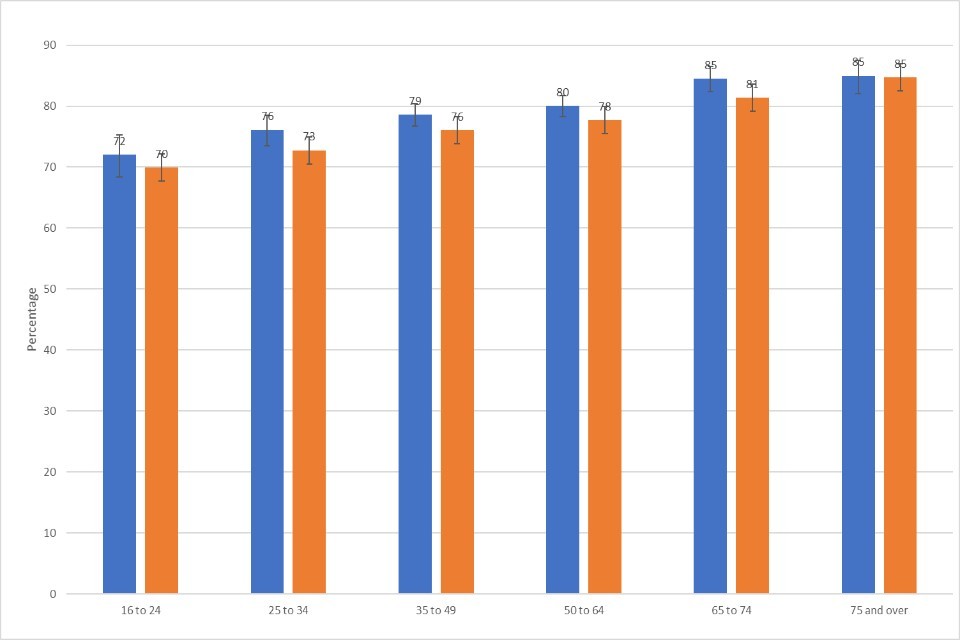
Figure 3.8: Percentage satisfied with local area by IMD quintile, 2020/21-2021/22 [footnote 4]
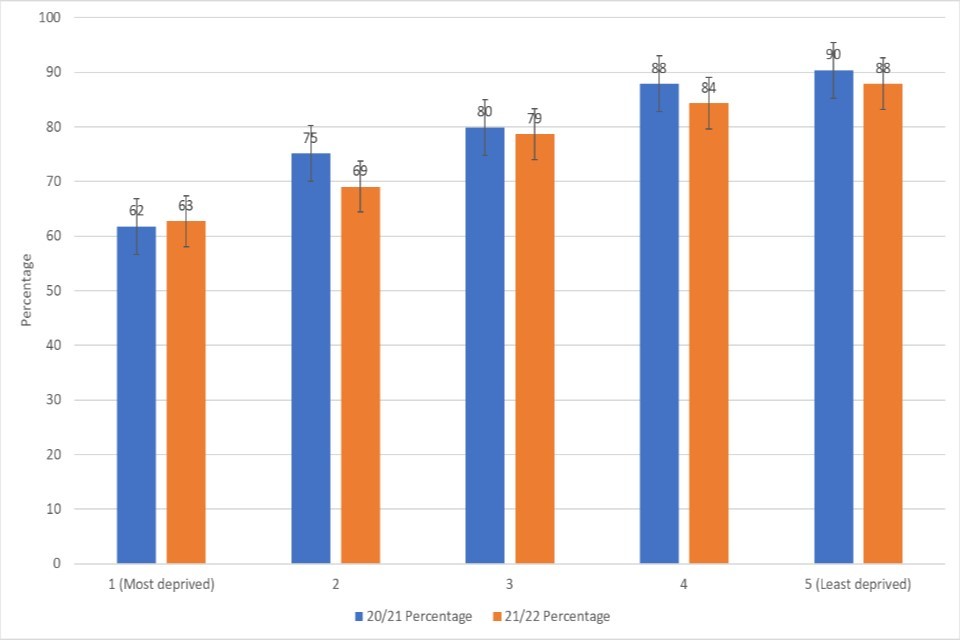
14% of respondents reported that over the last two years their area had got better to live in, a decrease from 16% in 2020/21. The majority of respondents said that it had not changed much (56%), a decrease from 2020/21 (63%).
Figure 3.9: Percentage of respondents who felt their area has got either better, worse to live in or has not changed much in the last two years, 2020/21 – 2021/22
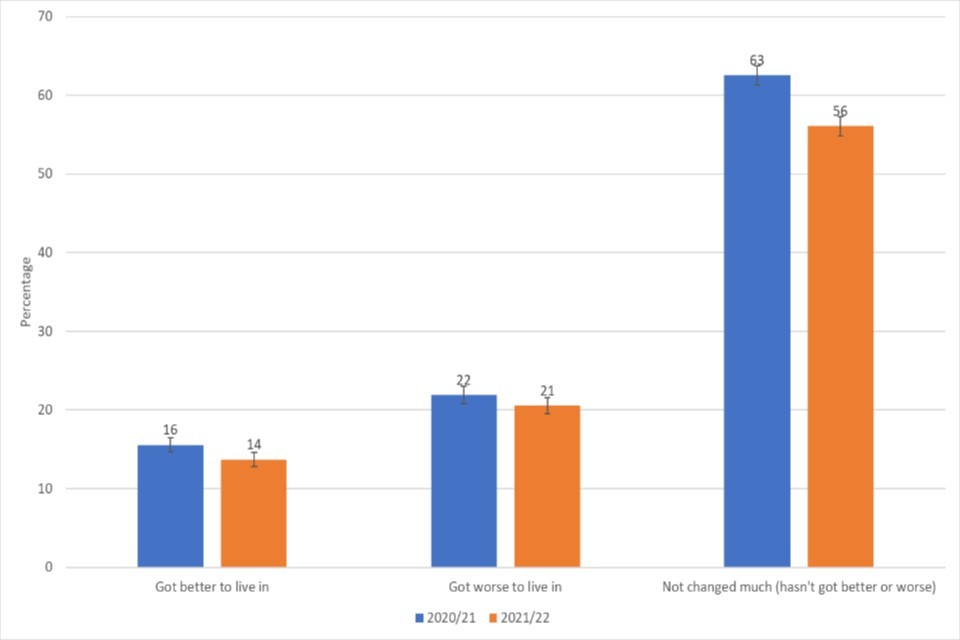
4. Feeling of belonging to neighbourhood
Respondents were asked how strongly they felt they belonged to their immediate neighbourhood.
In 2021/22, the proportion of respondents who feel they ‘very strongly’ or ‘fairly strongly’ belong to their immediate neighbourhood was 63% (approximately 29 million people in England), similar to 2020/21 (65%). Up to 2020/21 there had been an ongoing upward trend in the proportion of respondents who felt ‘very strongly’ or ‘fairly strongly’ that they belonged to their immediate neighbourhood, from 58% in 2013/14.
Figure 3.10: Percentage of adults (16+) who said they feel very strongly or fairly strongly belong to their immediate neighbourhood, 2020/21 – 2021/22
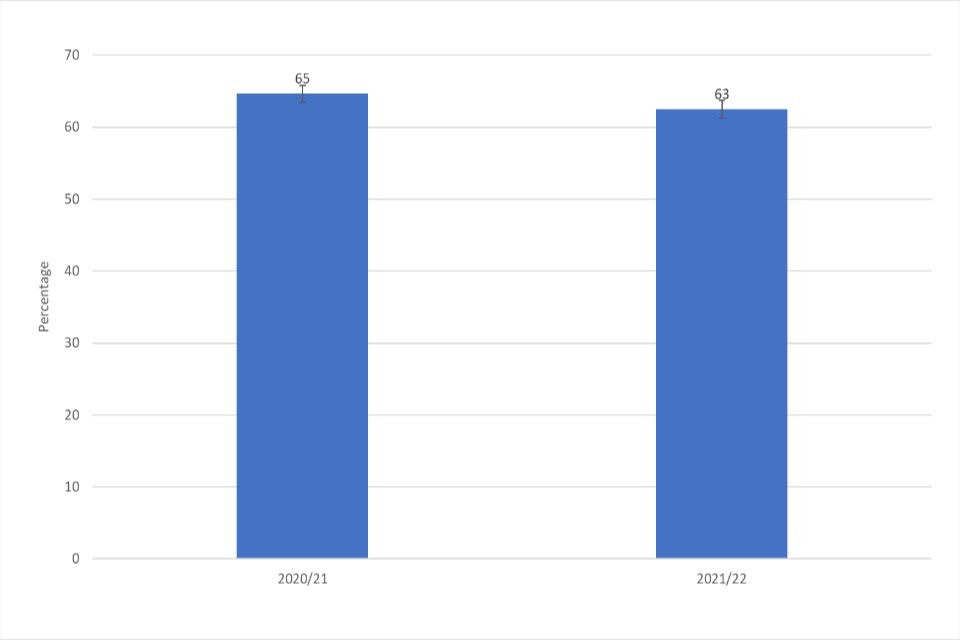
Those who identified as male were less likely than those who identified as female to feel strongly or fairly strongly that they belong to their neighbourhood (61% vs 64%).[footnote 4]
Respondents aged 75 and over were more likely to feel strongly (71%) that they belong to their immediate neighbourhood than all other age groups (54% to 65%), with the exception of those aged 65-74 (69%).
Figure 3.11: Feeling very/fairly strongly that they belong to their immediate neighbourhood by age group, 2021/22
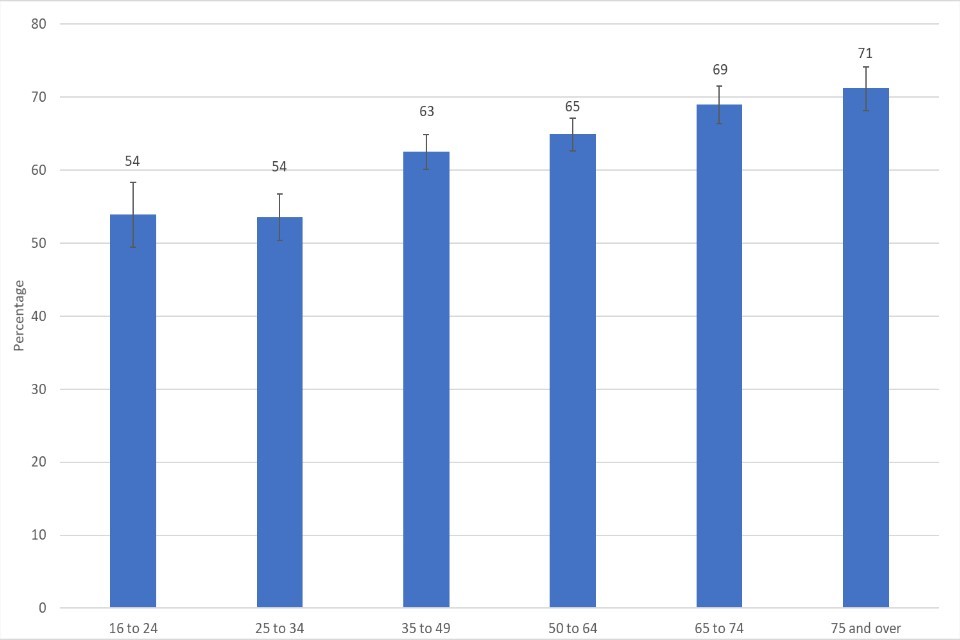
Respondents identifying as being from other ethnic groups were less likely to report they strongly or fairly strongly belonged to their neighbourhood (49%) than respondents identifying as from an Asian ethnic group and a white ethnic group (both 63%). There was no change in response figures from 2020/21 to 2021/22 for each ethnic group.
Those without a long term limiting illness or disability were more likely to agree that they belonged to their immediate neighbourhood than those with (65% vs 59%). These figures were consistent with 2020/21.
Some regional variability was seen, with those in London (56%) less likely to agree than those in all other regions (62% to 66%), with the exception of the South West (60%). There was no change from 2020/21 to 2021/22 for respondents in each region.
Respondents living in a rural area (72%) were more likely to feel strongly that they belonged to their immediate neighbourhood than those living in urban areas (60%).
People from the least deprived areas (69%) were more likely to agree that they felt strongly that they belonged to their neighbourhood than those from the most deprived areas (55%).
Figure 3.12: Feeling very/fairly strongly that they belong to their immediate neighbourhood by IMD quintile, 2021/22
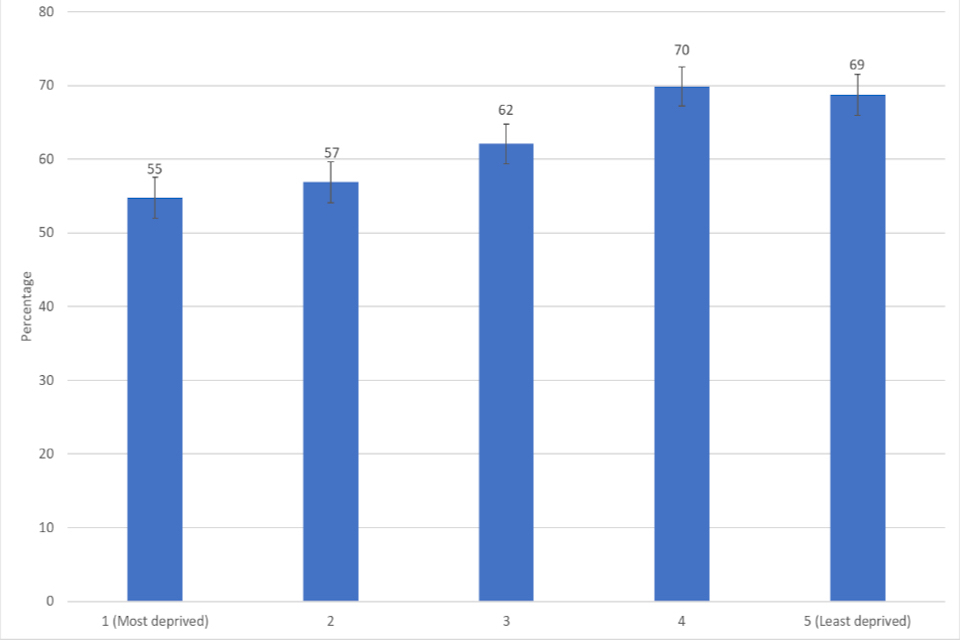
-
The 95% confidence intervals are indicated by error bars on the charts. They show the range that we are 95% confident the true value for the population falls between. When there is no overlap between the error bars for two or more groups, we can be more confident that the differences between groups represent true differences between these groups in the population. ↩
-
The Index of Multiple Deprivation, commonly known as the IMD, is the official measure of relative deprivation for small areas in England. It is calculated using several measures such as income deprivation, crime and living environment deprivation. The Index of Multiple Deprivation ranks every small area in England from 1 (most deprived area) to 32,844 (least deprived area). In this publication, we have clustered these areas into ‘IMD Quintiles’ with 1 being the most deprived areas and 5 being the least deprived areas. ↩
-
Figure 3.5 does not sum to 100% due to the presence of missing values in the data. These include all those who answered ‘Just moved here’ or ‘Don’t know’. Please refer to the Technical Annex for more information on how missing data was handled. ↩
-
Respondents who reported their gender as ‘other’ have not been included in this chart due to the number of respondents being small and therefore potentially disclosive. ↩ ↩2 ↩3
